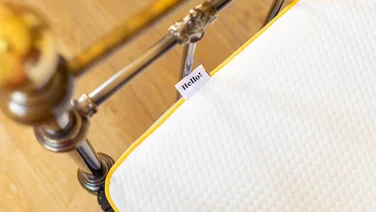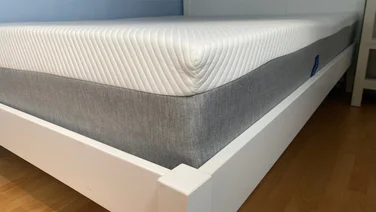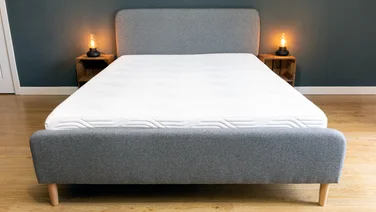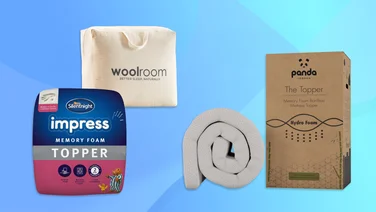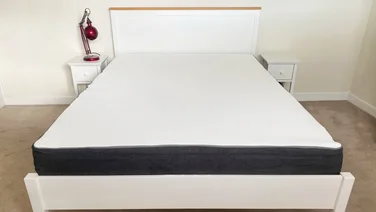To help us provide you with free impartial advice, we may earn a commission if you buy through links on our site. Learn more

Here at Expert Reviews, we’ve tested more than 50 mattresses, so we can confidently offer our readers informed recommendations and comprehensive buying advice.
We know how difficult it is to review a mattress and, over time, we have come to appreciate that it’s near-impossible to make a completely objective judgement of one. So we don’t try to do that. We review mattresses principally by sleeping on them, and we recognise how much of a subjective experience that can be.
We do, however, mix a healthy dose of objectivity in, running some standardised tests around sinkage and temperature control. And we make sure we test each mattress in as consistent a fashion as possible, so each gets a fair crack of the whip. Below is an explanation of how we go about this, as well as what else we look out for in a good mattress.
READ NEXT: The best mattresses to buy from Simba, Emma and more
How we test mattresses at Expert Reviews
As mentioned above, we review mattresses by sleeping on them. We don’t test mattresses in strict lab conditions because people don’t sleep in strict lab conditions. But we are methodical in the way we assess each mattress that we review. Each of our testers fills out a questionnaire into which they log their impressions as well as their test results (more on this later).
Here are the factors we consider during testing:
Comfort and support
Is the mattress comfortable to sleep on? This is, perhaps, the most obvious question one needs to answer when reviewing a mattress, but it’s not as simple as just that; there is nuance within that.

Does it feel too soft? Is it too hard? Or does it strike a nice balance between cushioning and support? The most comfortable mattress will feel different for different people, since people have different preferences when it comes to firmness and sleeping position. This is why, when we’re reviewing a mattress, we take care to think about what kind of sleeper it might be suited to.
Temperature control
The current trend in the mattress industry – certainly the bed in a box type – is for mattresses that are largely memory foam-based in their construction and foam mattresses tend to feel warmer to sleep on than traditional, spring-based mattresses.
That’s why we are careful to assess each mattress in this regard. Of course, the bedding that you use will also have an impact, as well your own body temperature (which itself is affected by a number of factors including body fat, metabolism, hormones, medical conditions and even stress). The temperature in the room will have an effect on your perception of this, too.
That’s why, for consistency, we also run some tests with a thermocouple probe and heat pack to measure each mattress’ heat retention (more on this below).
Motion isolation
If you share a bed with a partner, you’ll want to look for a mattress with minimal motion transfer – particularly if that partner is a restless sleeper who is liable to toss and turn at night. A mattress with good motion isolation means that movement on one side of the mattress won’t cause a disturbance on the other side. While we don’t carry out any specific tests to measure motion isolation (one such way to do this would be to place a glass of water around the centre of the sleep surface and apply pressure to the mattress around it), we do take it into consideration if we are testing alongside a partner – and any disturbances caused by restless movements will be noted.
If motion isolation is a priority, a memory foam mattress (or a hybrid mattress with a foam top layer) might be the right choice for you: the material absorbs motion as well as heat.
Bed base
The base on which you put your mattress will also have an impact on how the mattress feels. For instance, a mattress on a sprung-slatted frame might feel more cushioned than one on a solid base such as a divan.
Because we review mattresses at home, we’re often unable to test how they feel on every type of bed base. However, where possible, we make an effort to try the mattress on the floor as well as on our bed frame. This gives us a consistent frame of reference when comparing one mattress with another.
Value for money
Last, but not least, we consider value for money. This can be a bit tricky to judge, especially when mattress manufacturers are constantly having sales, reducing and increasing prices, seemingly by the day.
To make things easier and fairer, we focus on the price of a double mattress – one of the most commonly available and purchased sizes in the UK – and we only consider a mattress’s value for money based on its list price (before any temporary price reduction has been applied).
For price comparisons with other mattresses, we do the same, taking the long term current price for a double mattress (ignoring any temporary discounts). Since most mattress manufacturers reduce their prices frequently, this gives a fair baseline to work from.
From there, it’s the usual process of factoring the quality of materials, the length of the free trial, any warranties and how well the mattress performs during the testing period, so we can arrive at a fair and balanced verdict.
And this is important because value for money is not dictated solely by price. A mattress may be cheap, but it will only deliver great value if the product itself is great to sleep on, too.
Our standardised tests
As mentioned above, there are a few tests we run that allow us to get measurable data for the mattresses we review, in order to balance our subjective opinions of a mattress with objective, empirical data.
Firmness tests
These tests are carried out with the mattress placed on a solid surface to ensure consistency from mattress to mattress, because not every mattress is reviewed and tested by the same person.

We do this by placing a standard A5 notebook at the centre of the sleeping position (around the chest centre, if a person was sleeping on their back) and placing a series of 2.5kg weights on top of the notebook, measuring the distance the notebook sinks with the placement of each weight. By measuring how far the mattress sinks under weight, we get an idea of how supportive it is. As the graph below suggests, the higher the deflection/sinkage, the softer the mattress.
We also repeat this test towards the edge of the mattress, placing the notebook and weights 2.5cm to gauge edge firmness is. If it’s similar to the test results taken more towards the middle, then the mattress has good edge support; if the weights sink a lot further, then the opposite is true.
For good measure, we also measure how much the full 10kg stack of weights tilts when placed at the edge of the mattress: a mattress with good edge support will exhibit little or no tilt at all in this test.
Temperature retention tests
There are two tests we run to measure temperature retention: one relying on body heat, the other using a heat pad to provide a more consistent heat source. For both, we use a thermocouple and take our measurements without any sheets or bedding on the mattress.

For the body temperature test, we start by sitting on the mattress with the thermocouple probe placed underneath us. Once the thermocouple reads 30°C, we get up and quickly place a paperback book and one 2.5kg weight on top of the probe. For the next ten minutes, we record the temperature at one minute intervals.
The heat pad test follows a similar process. After heating up the pad in boiling water, we place it on top of the probe in the same position in which we were sitting. We wait for the temperature to fall to 50°C, then we remove the heat pad and replace it with the paperback book and place a 2.5kg weight on top, as before. Again, we record the temperature at one minute intervals for ten minutes, to judge how quickly the mattress cools.
Of course, real-life use involves bedding and body heat warming up the mattress over much longer time periods, but these tests at least give us an idea of how much a mattress retains heat.

